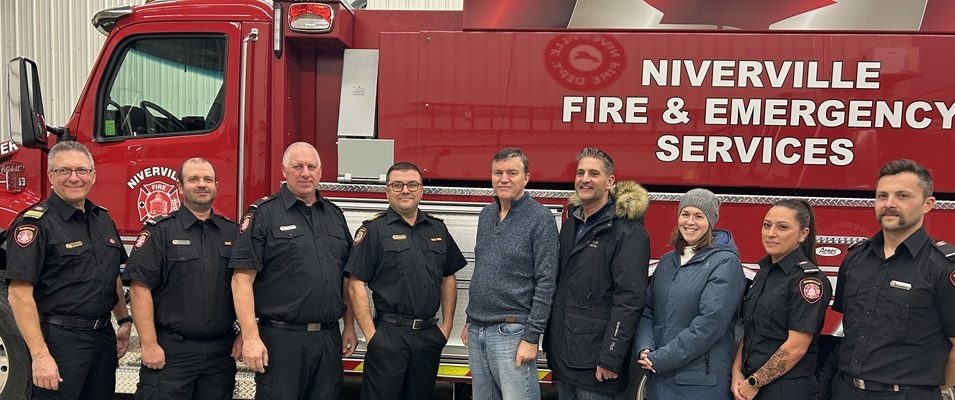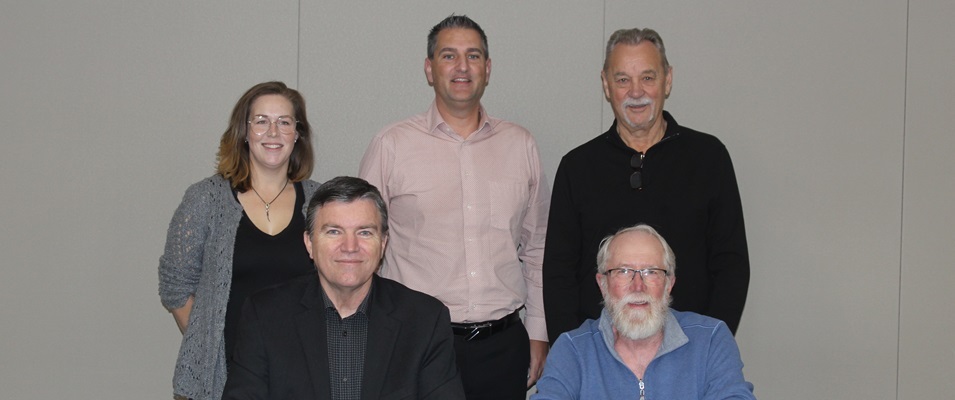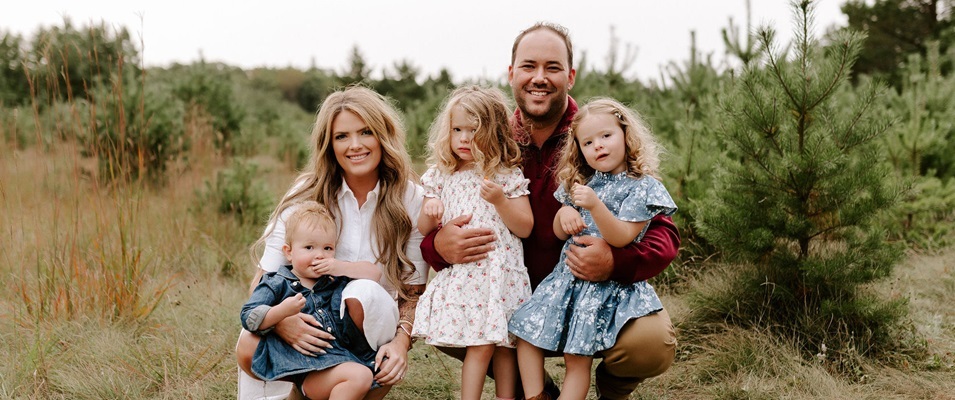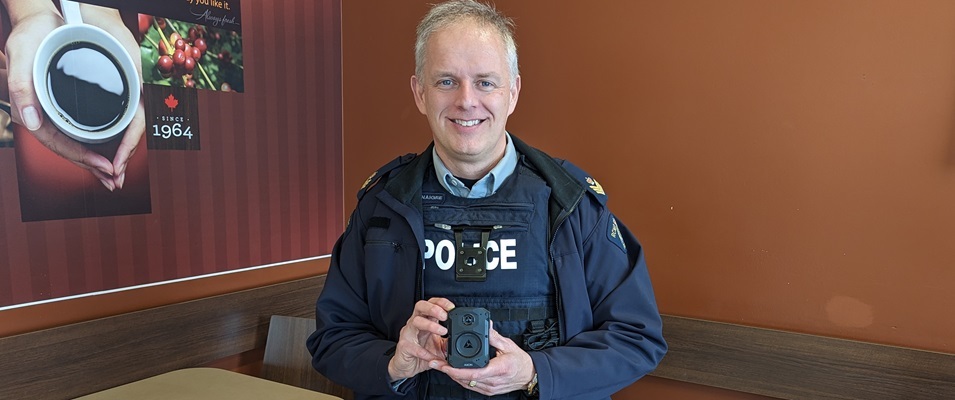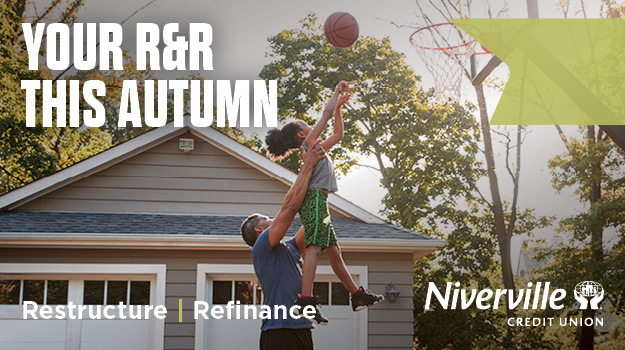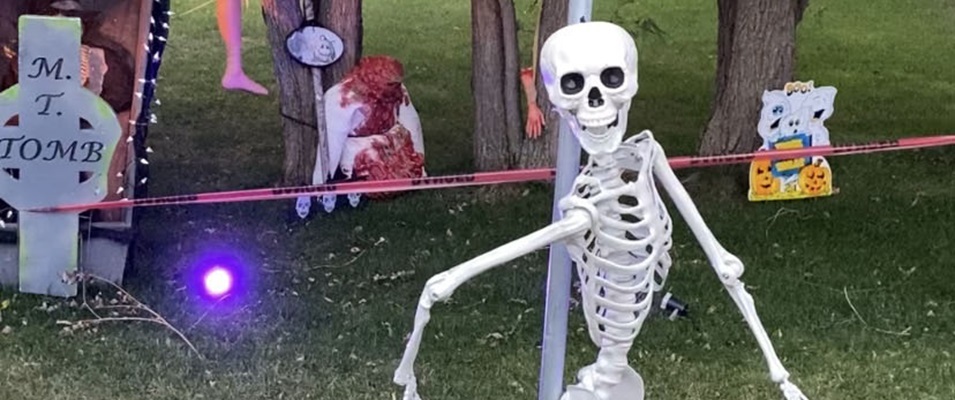
It’s the holiday at the end of fall that sees parents striving to roll Tinkerbell and Superman tights over long underwear and snowsuits. It has long been demonized for its origins and increase in violence and mischief. Anyone concerned about sugar intake, serious food allergies, or sensory issues has plenty of valid reasons to direct their ire at this macabre time of year.
It’s Halloween! And despite its hangups, this pumpkin-carving, scare-inducing holiday can be full of community fun—nothing to get all “chai-and-mighty” about.
For community advocate Barry Piasta, Halloween is one of his favourite opportunities to create fun for his neighbours in Niverville.
“Halloween’s fun. Everybody likes to be a little bit scared or surprised. I do it for the kids to enjoy. I’ve got a hand like from the Addams Family, that walks around here that amuses everybody. I try not to make it too scary,” says Piasta, who sets up somewhere between 1000 and 2500 Halloween decorations in his yard.
Piasta originally became a Halloween enthusiast in response to a note he received when he first moved to Niverville.
“When we first moved out here in 2010, I just had one of those blow-up [decorations], three pumpkins stacked,” says Piasta. “I left for the evening and when I came back I found a note stuck to my front door that said this is a Christian community and we don’t support pagan rituals. So I went to the store and bought some more and put them up. And then every year, whether it’s Christmas, a birthday, or whatever, I tell my loved ones to get me some Halloween decorations.”
Piasta says the response he gets from his display now is positive and people walking by usually say “Wow!” and “That’s cool.”
Most of all, he enjoys when whole families come through his yard and then get to talking amongst each other. He and his wife have provided free cookies and hot chocolate in colder years to help keep people warm. They’ve even encouraged their community to do a food drive.
“It’s a way for everybody to meet everybody,” he says. “I get not just kids coming through, I get parents coming by, looking at it, getting a kick out of it. Every day I have a few cars looking at what I’ve got set up or people will already stop and chat.”
Piasta recently hosted a local daycare group who came through his yard during the day with all the kids and daycare workers in costume. He says that on Halloween night, if there are kids who don’t want to come right up to the display to get candy, he has brought the candy out to them.
“Yeah, there are some parents who won’t let their kids come here, but we’ll come out to the street to bring them chocolates, which is all fine. We can do that. It’s a community effort.”
Halloween with a Cause
Holidays and traditions are rarely celebrated alone and can bring a sense of belonging. When a large number of people live in community together, practicing diversity awareness and acceptance can make events safer and more welcoming for all.
For parents of children with life-threatening allergies, Halloween can be a trickier holiday than others because of how central food is to the celebration.
Jen Gower has two children under the age of seven who have anaphylactic reactions to certain foods. When their family was first learning about the severity of these children’s allergies, she seriously considered not trick-or-treating.
“Halloween for most young people is one of the few times of the year where, yes, it’s all about the food, the candy,” says Gower. “All you want to do when it comes to kids is try to include them. They want to be included and not be the ones missing out.”
While being vigilant about the candy being placed in her kids’ bags at Halloween, Gower says they have still managed to find ways to enjoy the evening.
“We’re cautious, yes, but there’s nothing we can’t do. We just have to try to do it differently,” she says. “We ensure our family isn’t eating the items out on the street. We come home and switch the items that are unsafe or questionable. We’ll separate them out for other items they can have, or goods that aren’t food.”
Gower believes a community initiative—for example, the Teal Pumpkin Project, where a teal pumpkin on a doorstep means the house is handing out non-candy goods as Halloween treats—could help ensure more children feel included on Halloween.
She also acknowledges that there are a lot of special needs issues represented in the community.
“It’s not just allergies for young ones, but things like sensory items or a spectrum of other issues. I know you can’t cover all the bases,” says Gower. “The teal pumpkin focuses on allergies, and there are other pumpkin colours that have been created to address a number of awarenesses, like darker blue is for autism awareness.”
Gower says that if you plan to offer non-food treats or calm lighting and no jump-scare decorations, it would be good to put your coloured pumpkin outside before October 31 so parents of sensitive youngsters can plan to visit your house.
Gower would also encourage parents to have more dialogue with their children, and even educate themselves on what an inclusive Halloween means to the greater community.
“You can get reusable, plastic pumpkins or you could paint a pumpkin with your children and talk to them about why it’s important to be inclusive of others who are different than us in the community,” says Gower. “If you’re around people who are allergic, avoiding food dyes, or practicing not having as much sugars, or accommodating differences like being of taller stature, but still developmentally young, or with other neurodivergent needs, you’ll see a variation of all of those needs affecting our society during Halloween, so it’s good to be kind and be aware.”
What About Sugar?
In the world of nutrition, sugar has risen to infamy as the new “supervillain” in the story of good health, but one local nutritionist advocates a more balanced view.
“The buzz around Halloween largely depends on one’s perspective,” says Susan Watson, registered dietitian, busy mom of two, and the owner of A Little Nutrition in Winnipeg. “Sure, Halloween is synonymous with candies and chocolate, but they can be enjoyed without fear or worrying too much over nutrition.”
Watson says that the current climate of parental shaming and an intense diet culture might have us on edge about our kids’ Halloween candy consumption, even though this wasn’t as big a deal a few decades ago.
“For me, it’s less about stressing over every candy bar and more about promoting a positive relationship with all foods,” she says. “It’s crucial to remember that our health isn’t just about what we eat on a single day.”
Instead of contributing to fear-based messaging around sugar, Watson encourages shifting from calling treats “unhealthy” foods and instead helping families to learn about fullness cues and making food choices that feel satisfying and enjoyable to them, without guilt or shame attached.
“Consuming a large dose of sugar on Halloween night is no different from the amount one might consume at other festive events like the Niverville Olde Tyme Country Fair, a birthday party, or a celebration,” says Watson. “What we need to look at is how we teach our kids to connect with our bodies and regulate what feels good and what feels bad. If you are someone who limits their kids’ candy, they are not learning to assess pushing their bodies’ limits and how to manage eating to a point of satisfaction rather than going overboard. If something is restricted or forbidden, we often want it more.”
As a parent of young kids, Watson knows how hard it can be to model a healthy relationship with food for the young people in our lives and asks parents to assess their own relationship with food before creating their family’s Halloween rules.
“Often there is a fear of their kids being ‘out of control,’ which often is rooted in [parents’] own fears of being out of control around sugary foods. I don’t call Halloween candy ‘treats.’ I direct parents to call it ‘fun foods,’ or what it is—candy. A treat can imply a reward, or that it is something that has moral value. Food doesn’t have moral value.”
But with all the negative messaging around the sugar available at Halloween, does Watson actually practice what she preaches?
“I approach Halloween very neutrally. I buy a box of my favourite Halloween candy and have it available for me to eat when I feel like it,” she says. “If it is available, and I allow myself to have it, it’s no big deal. If candy is scarce and a limited thing, you might be more reactive with it.”





